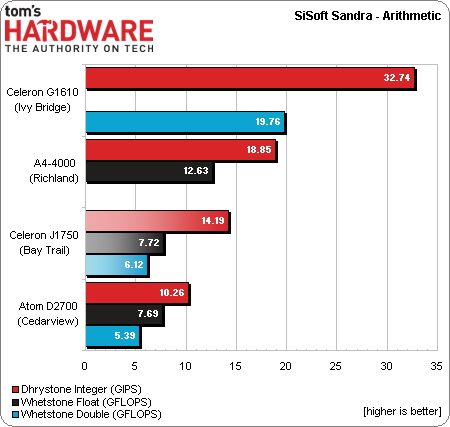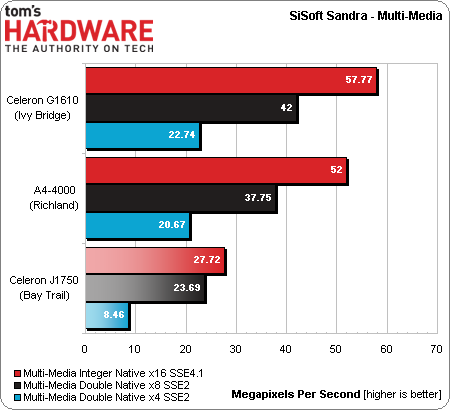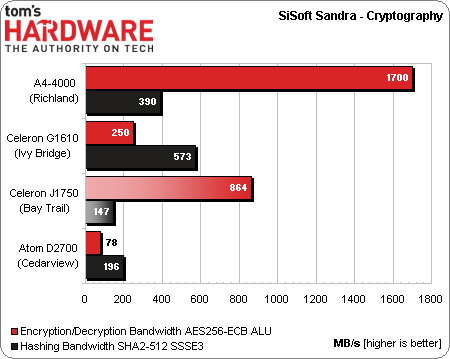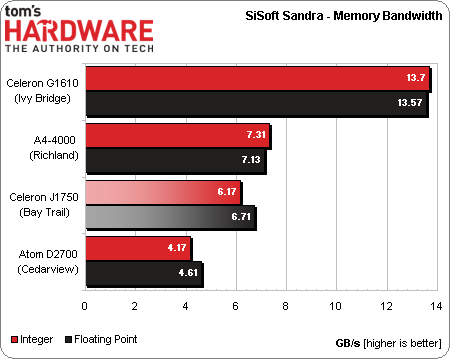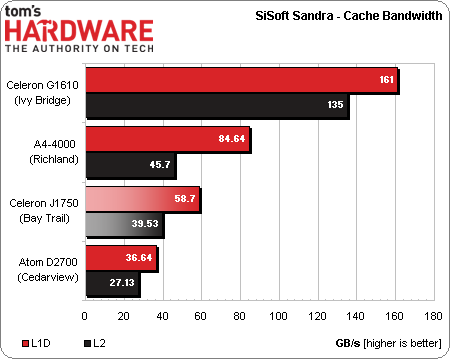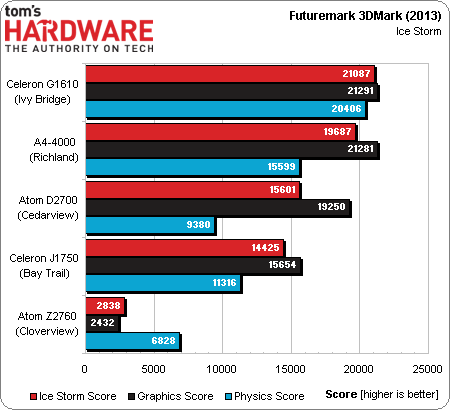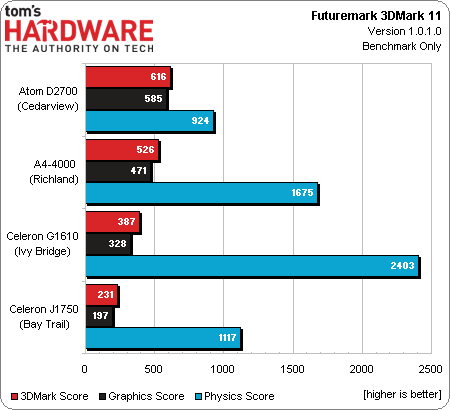Bay Trail On The Desktop: Celeron J1750 Gets Benchmarked
Last week, Intel rolled out its Bay Trail SoCs based on the Silvermont architecture. The company focused most intently on its tablet-oriented Atom models. However, we got our hands on a Celeron J1750, soldered onto a motherboard, for desktop testing.
Results: Synthetics And 3D
As mentioned, we're scaling back on the number of tests for today's preview. Much of our typical benchmark suite is workstation-oriented. Compiling lots of code, editing professional video, and rendering big 3D projects probably won't happen very often on a system with a Celeron inside. When it does, you're going to wish you had picked up something else.
Let's start with the basic synthetics, though. Sandra's Arithmetic module recognizes each processor's ISA extensions and capitalizes. Still though, the Ivy Bridge-based Celeron and Richland-based A4 are both quite a bit quicker.
The Atom D2700-based setup wouldn't complete the Multi-Media sub-test. Instead, we get a look at the advantage Ivy Bridge and Richland enjoy over the Bay Trail SoC.
The Silvermont processor architecture includes AES-NI support. Intel deliberately cuts that feature from the Celeron G1610 though, explaining why Bay Trail posts better numbers. Cedarview clearly lacks AES-NI, while Richland leverages it. Curiously, Bay Trail is outperformed in hashing by the Hyper-Threaded Atom D2700.
These platforms support different memory configurations. The Celeron G1610 supports two channels of DDR3-1333. AMD doesn't make clear what the A4 supports, but we ran it with DDR3-1600 modules that defaulted down to 1333 MT/s. Our Atom D2700 system took two 2 GB DDR3-1066 modules (albeit using one 64-bit channel). Meanwhile, our Celeron J1750 is rated for DDR3L-1333 at 1.35 V.
3DMark
Bay Trail might appear to falter, but remember that it's going up against two CPUs derived from more powerful desktop architectures (even if they're both $50 chips), and an Atom D2700 backed by Nvidia's GeForce GT 520.
Most important, perhaps, is that our dual-core Celeron J1750 manages to outscore the dual-core, Hyper-Threaded Atom D2700 in 3DMark's Physics test, which measures host processor performance.
Get Tom's Hardware's best news and in-depth reviews, straight to your inbox.
As a point of comparison, you can see how badly the Atom Z2760 in Intel's tablet-oriented Cloverview process fares.
The situation similarly doesn't look much different for Bay Trail in the older 3DMark 11. What drags it down is the graphics score, though. You can clearly see that two Silvermont cores outperform a pair of Hyper-Threaded Saltwell cores. This test doesn't run on the ATIV Smart PC 500T, so we can't include that platform's numbers, which would have undoubtedly been ugly.
Current page: Results: Synthetics And 3D
Prev Page Results: Power And Efficiency Next Page Results: Productivity-
SteelCity1981 only 2mb of l2 cache for 4 cores. talk about starving 4 cores with 2mb of l2 cache.Reply -
DjEaZy ... interesting is the modular core thingy.. it ir like the FX module from AMD... 2 cores on joined L2 cache? Hmm... and GPU on the silicon... it seams, intel waits till the software is there...Reply -
stickmansam Reply11551610 said:... interesting is the modular core thingy.. it ir like the FX module from AMD... 2 cores on joined L2 cache? Hmm... and GPU on the silicon... it seams, intel waits till the software is there...
Shared L2 cache exists on Intel's side during the Core 2 era with two or more cores sharing the L2 cache, similar to how L3 cache is shared now except there is an additional private L2 cache. Basically, with Nehalem, Intel moved the shared cache a level lower to L3 and put in a new private cache (L2). GPU on the same die/chip has been on Intel's side too for quite a while as well....
11551497 said:only 2mb of l2 cache for 4 cores. talk about starving 4 cores with 2mb of l2 cache.
The i5s have actually less cache than the Q9x50's so cache size isn't everything. Their ipc is still lower than the Athlon IIx4's which have similar amounts of cache are not that bottle necked (compared to Phenom II's, maybe 20% slower?). Cache implementation also matters and the shared L2 should be better than the piecemeal Athlon II L2, provided the cores don't thrash each other.
Bay Trail is a quite interesting chip with good enough performance to pretty much beat out most ARM chips in tablets yet provide comparable power efficiency and graphics. The price is not too high either, with the top end chip ~$40, making it at least somewhat competitive with ARM. The ability to run Android/Linux/Windows 8 means that OEM's can build one product to sell to different markets and save on production line costs. It also lets them adjust the OS to meet market demand on the go potential (ship non selling OS version back to factory and load OS that sells better and send it back out). ASUS seems to have something like that going on with the T100 having buttons half way between Windows and Android and no Windows branding.
This all makes me want to grab a Bay Trail and run both Android and Windows on it, have Windows when I use it connected to a screen for desktop and run desktop apps and then Android on the go so I get the larger app store (Windows if I am lazy). -
vipervoid1 There is Kabini in the review ??Reply
Why compare Richland with this ??
Isn't Kabini is the one to compare ?? -
runswindows95 Then again, the thing to keep in mind these CPU's aren't gaming / workstation CPU's. These CPU's will quite honestly work for the majority of PC owners, who mainly do social media and Youtube. A quad-core that only uses 10W intrigues me a lot since I don't game, but do a lot of heavy word processing.Reply -
ojas Reply
Agreed.11551718 said:There is Kabini in the review ??
Why compare Richland with this ??
Isn't Kabini is the one to compare ??
Though, Tech Report and AnandTech have previewed the Z3770 and put it up against mobile chips and Kabini.
(hint: the 4w Z3770 matches a 15w A4-5000 Kabini and soundly thrashes ARM in CPU performance)
http://techreport.com/review/25329/intel-atom-z3000-bay-trail-soc-revealed
http://www.anandtech.com/show/7314/intel-baytrail-preview-intel-atom-z3770-tested -
de5_Roy i sorely missed a kabini setup in the benches and efficiency tests. i woulda liked to see both bay trail and kabini socs run 1080p and 1600p gaming (tablet oriented).Reply
a few nitpicks:
in the test hardware chart - a4 4000 doesn't have L3 cache. afaik, neither does baytrail (1MB shared L2).
in the bga 65w skus vs bga 10 skus table, the core i- cpus clockrates are base clockrate, turbo is missing while baytrail socs' burst clockrate is reported while base clockrate is absent. -
Wisecracker Reply11552261 said:
Agreed.11551718 said:There is Kabini in the review ??
Why compare Richland with this ??
Isn't Kabini is the one to compare ??
Though, Tech Report and AnandTech have previewed the Z3770 and put it up against mobile chips and Kabini.
(hint: the 4w Z3770 matches a 15w A4-5000 Kabini and soundly thrashes ARM in CPU performance)
http://techreport.com/review/25329/intel-atom-z3000-bay-trail-soc-revealed
http://www.anandtech.com/show/7314/intel-baytrail-preview-intel-atom-z3770-tested
Not according to Tom's ...
Power consumption looks great ... especially compared to a 65w Richland desktop (WTF, THG?) ... but the A4-5000 remains quite formidable in efficiency according to Tom's own testing
Graphics performance compared to the AMD SoCs must blow, or it would have been hyped to the max. I suspect this means Bay Trail will be Temash'd (or, Kabini'd).
-
CaedenV Looks like these new Atom based Celerons and Pentiums are what I want to look for in my little always-on server build I am prepping for. Extremely low power, enough performance to run a gigabit NAS, and hopefully some passive or other extremely quiet cooling solutions. I just hope that the motherboards offer some RAID options to work with in FreeNAS and the price is appropriately cheap.Reply
